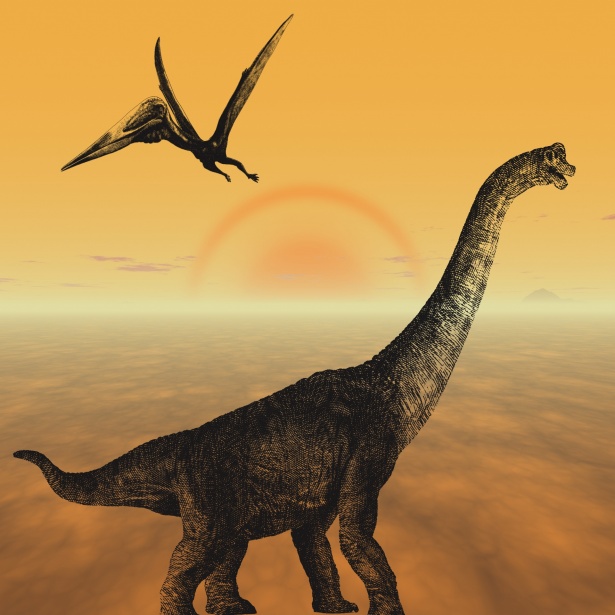Brachiosaurus is a genus of sauropod dinosaur that evolved during the Late Jurassic in North America around 154 million years ago. In this article, we’ll take a deep dive into Brachiosaurus, from its discovery to its distinctive physical characteristics to its habitat.

Discovery and Naming
The discovery and subsequent naming of Brachiosaurus marked a milestone in paleontology. American paleontologist Elmer S. Riggs first identified this dinosaur in 1903 in the Colorado River valley, within the Morrison Formation. This region, rich in prehistoric remnants, provided the perfect backdrop for such a significant discovery.
Riggs christened this specimen ‘Brachiosaurus altithorax‘. The dinosaur name translates to ‘arm lizard’, a nod to its unusually elongated arms, unlike other contemporary sauropods. The species name ‘altithorax’ denotes ‘deep chest,’ reflecting another unique anatomical feature.
Physical Description
The Brachiosaurus stretched an estimated 18 to 22 meters in length and weighed between 28.3 to 46.9 metric tons. Exhibiting the typical distinctions of a sauropod, the ‘Arm Lizard’ featured a disproportionately long neck and a small skull. However, it diverged from the norm with its forelimbs being longer than its hindlimbs, giving it a steeply inclined trunk and a proportionally shorter tail. This unique body structure, along with its immense size, distinguished it from its contemporaries.
Popular depictions often mistakenly confuse it with Giraffatitan, a brachiosaurid from the Lindi Region of Tanzania, though these depictions are not entirely accurate. While they share similarities, distinct anatomical differences set them apart: Giraffatitan usually boasted a more slender build and a longer, more flexible neck. Moreover, the proportions of their limbs differed, with Brachiosaurus possessing a more robust structure. These specific differences highlight their separate evolutionary paths despite their initial classification under the same genus.

Brachiosaurus Lifestyle and Habitat
The lifestyle and habitat of Brachiosaurus, as inferred from fossil evidence, suggest it was a high browser, feeding on vegetation well above the ground. The structure of its teeth and jaws indicates a diet mainly consisting of ginkgos, conifers, and ferns. Theories about its posture and locomotion have evolved over time, with current understanding leaning towards a terrestrial lifestyle, contrary to earlier beliefs of a semi-aquatic existence.
The animal’s respiratory system, akin to birds, featured a complex network of air sacs, enhancing its efficiency in oxygen intake and highlighting a potentially active metabolism.

Brachiosaurus Ecological Role
Brachiosaurus filled an important ecological niche in the Late Jurassic landscape. Its stature allowed it to access high-canopy vegetation, reducing competition for food among herbivores. As a high browser, its feeding habits may have played an important role in seed dispersal.
The relationship between Brachiosaurus and contemporary carnivores is complicated. Its sheer size would have deterred many predators, though young or unwell individuals might have fallen prey to the likes of Allosaurus or Ceratosaurus. Smaller herbivores might have even stuck around Brachiosaurs for protection.
The Holotype Specimen and Other Finds
The holotype specimen of Brachiosaurus, FMNH P 25107, remains the most complete and significant find of this genus. Discovered by Riggs and his team, this specimen comprises several crucial bones, including the right humerus, femur, ilium, and sacrum. Housed at the Field Museum of Natural History in Chicago, this specimen has played a key role in shaping our understanding of the animal.
Additional finds across North America have complemented the holotype specimen, adding more depth to our knowledge of this magnificent dinosaur.

Popular Culture Depictions

Brachiosaurus has captured the public’s imagination, most notably through its memorable appearance in the 1993 film Jurassic Park. Despite certain inaccuracies in its depiction, the Brachiosaurus scene took the audience’s breath away, making it a cultural icon.
Children’s dinosaur books often feature Brachiosaurus altithorax, captivating young readers with its enormous size and unique appearance. The dinosaur also frequently appears in dinosaur-themed video games, appearing in popular titles such as the “Jurassic Park” and “Jurassic World” series, “ARK: Survival Evolved,” and “Primal Carnage.” In these games, players may encounter or play as this iconic dinosaur, adding to the immersive experience.









